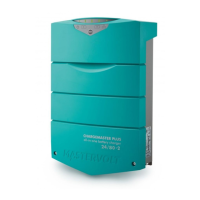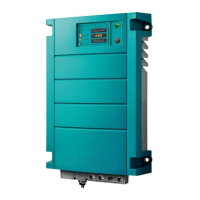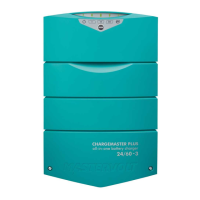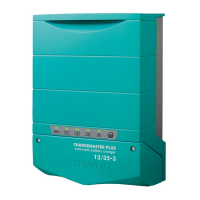INSTALLATION
EN / Chargemaster 12/25-3, 24-12-3 / February 2010 9
4.4 OVERVIEW CONNECTIONS
4.5 THINGS YOU NEED
Make sure you have all the parts you need to install the Chargemaster: Quantity
Chargemaster (included) 1
Battery temperature sensor with cable and plug (included) 1
MasterBus terminator
MasterBus cable
DC cable to connect the positive DC connection (+) of the Chargemaster to the positive pole of the DC-
distribution; for specifications see section 4.3.1. Cable 1250 mm, 6.0 mm² / 4.10 ft, 9 AWG.
1
DC-cable to connect the negative DC connection (–) of the Chargemaster to the negative pole of the DC-
distribution; for specifications see section 4.3.1. Cable 1250 mm, 6.0 mm² / 4.10 ft, 9 AWG.
1
DC-fuse holder with a DC-fuse, to be integrated in the positive DC-cable. For specifications see section 4.3.1. 1
Screws / bolts (Ø 5mm) (with plugs) to mount the cabinet to a surface. Use mounting materials which are
suitable to carry the weight of the Chargemaster.
4
1.5 m AC cable to connect the AC input to an external power source (e.g. a shore connection or a generator set). 1
Batteries. See section 4.3.1 for recommended capacity. X
Appropriate and reliable cable terminals, cable lugs, battery terminals and cord end terminals X
See also chapter 7 Ordering Information. We recommend as a minimum tool kit a flat blade screw driver 1.0 x 4.0 mm to fix the
screw terminals and tools to fix the screws / bolts (Ø 5mm) with plugs to mount the cabinet to a surface
4.6 CONNECTIONS
WARNING
Let installation work be done by a licensed
electrician. Before connecting the wiring,
make the AC distribution as well as the DC
distribution voltage free.
CAUTION!
Short circuiting or reversing polarity may
seriously damage the batteries, the
Chargemaster, the cabling and/or the terminal
connections. Fuses between the batteries and
the Chargemaster can not prevent damage
caused by reversed polarity. Reverse polarity
damage is detectable by the service
department and not covered by the warranty.
CAUTION!
Too-thin cables and/or loose connections can
cause dangerous overheating of the cables
and/or terminals. Therefore tighten all
connections well, in order to limit transition
resistance as far as possible. Use cables of
the correct size.
NOTE:
If the battery temperature remains within 15-
25°C, connection of the battery temperature
sensor is an option.

